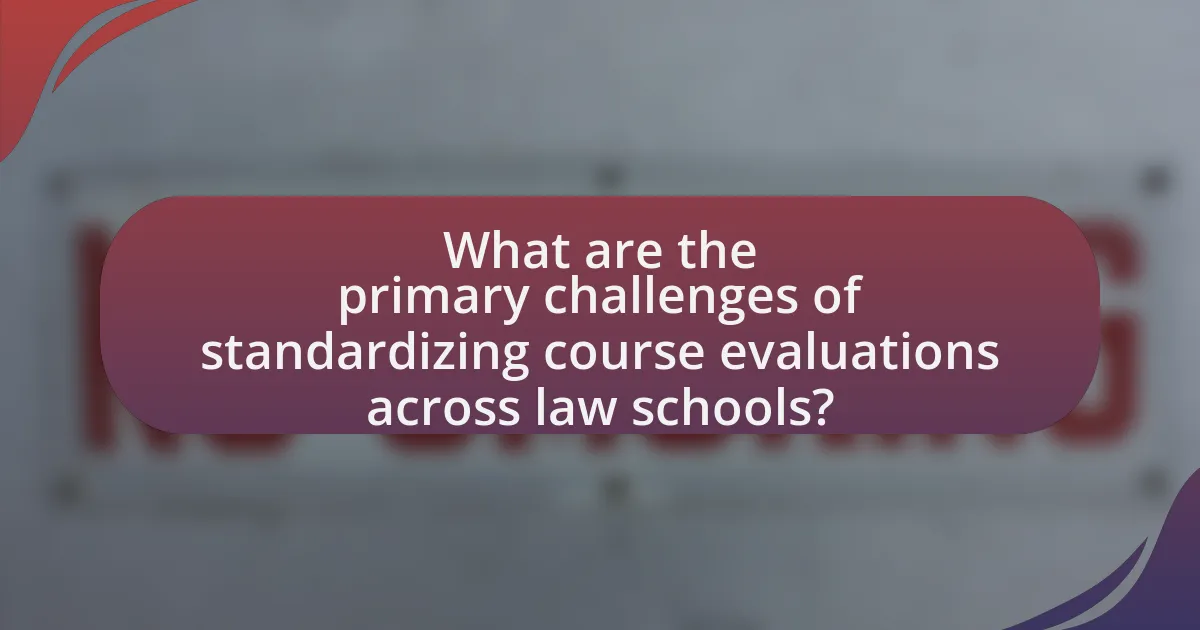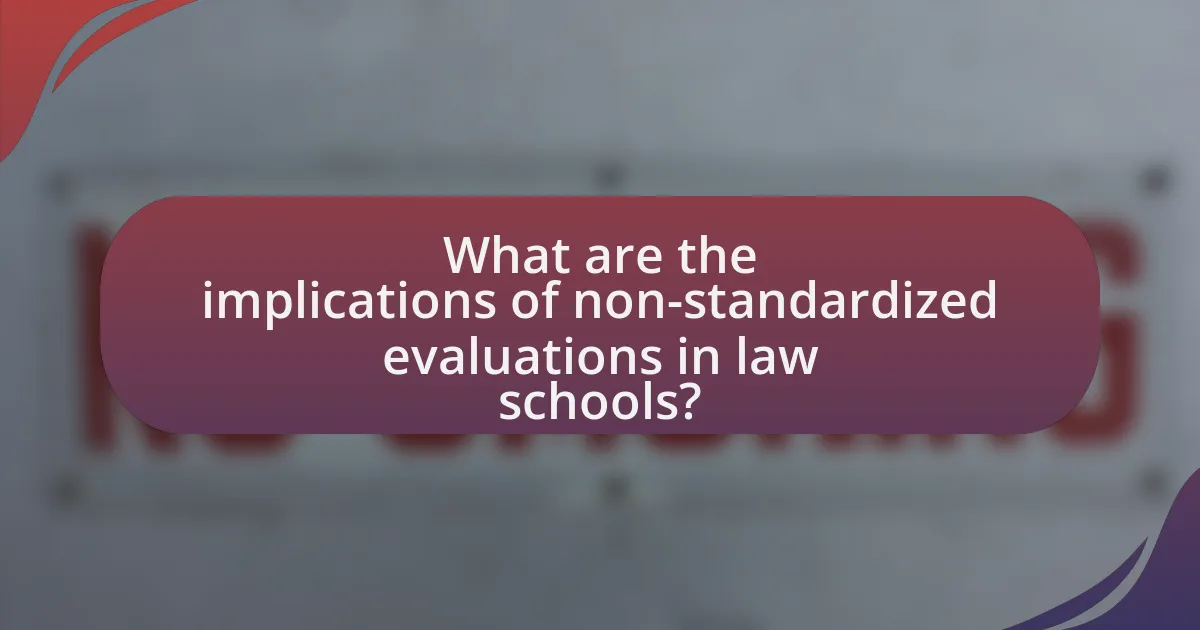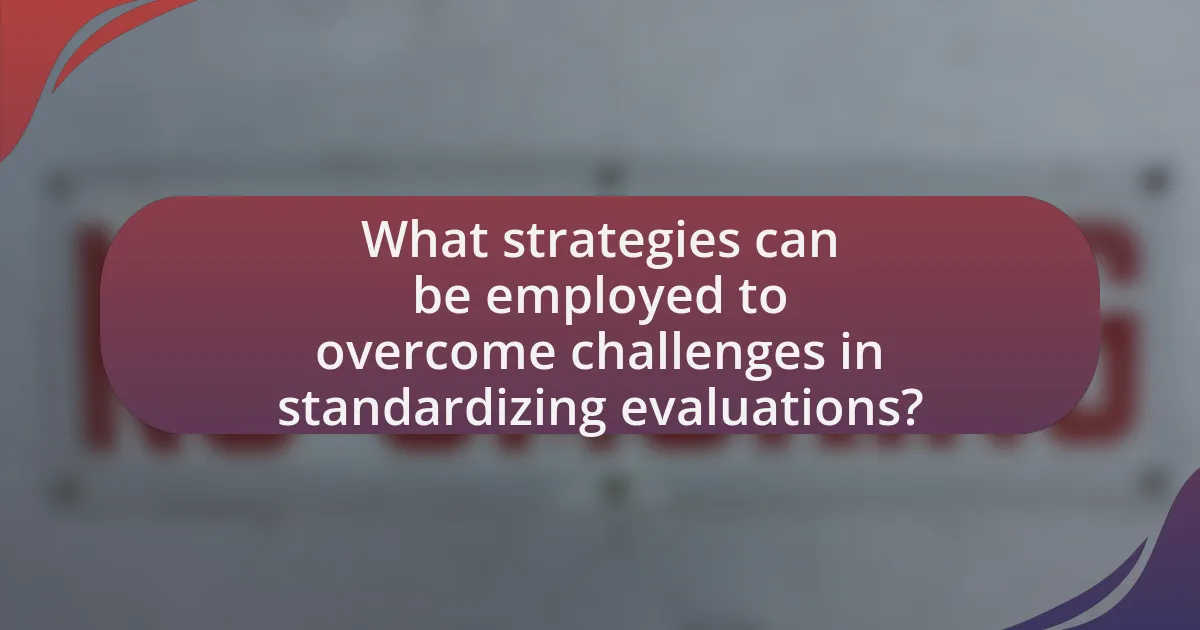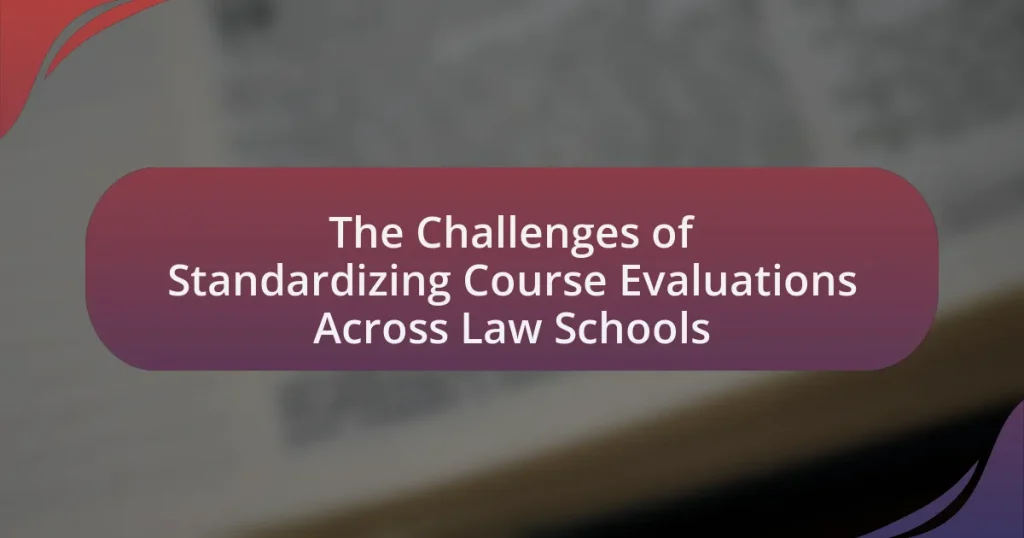The article examines the challenges of standardizing course evaluations across law schools, highlighting key issues such as varying institutional priorities, differences in curriculum structure, and diverse student demographics. It emphasizes the importance of standardization in legal education for ensuring consistent quality and improving educational outcomes. The article also discusses the potential benefits of standardized evaluations, including enhanced accountability and improved student satisfaction, while addressing obstacles such as faculty resistance and variations in teaching methodologies. Additionally, it explores the implications of non-standardized evaluations on student learning outcomes and faculty development, and suggests strategies for overcoming these challenges through collaboration and the use of technology.

What are the primary challenges of standardizing course evaluations across law schools?
The primary challenges of standardizing course evaluations across law schools include varying institutional priorities, differences in curriculum structure, and diverse student demographics. Institutional priorities can lead to different evaluation criteria, as some schools may emphasize teaching effectiveness while others focus on course content. Differences in curriculum structure, such as the balance between theoretical and practical training, complicate the creation of a uniform evaluation system. Additionally, diverse student demographics, including varying levels of preparedness and expectations, can skew evaluation results, making it difficult to establish a standardized measure of teaching quality. These factors collectively hinder the development of a cohesive and universally applicable evaluation framework across law schools.
Why is standardization important in legal education?
Standardization is important in legal education because it ensures consistency in the quality and content of legal training across institutions. This consistency is crucial for maintaining a uniform understanding of legal principles and practices among graduates, which is essential for their effectiveness in the legal profession. Research indicates that standardized curricula can lead to improved educational outcomes, as they provide a clear framework for what students should learn, thereby enhancing their preparedness for the bar exam and legal practice. For instance, the American Bar Association has established accreditation standards that promote uniformity in legal education, which helps ensure that all law schools meet minimum educational requirements.
What are the potential benefits of standardized course evaluations?
Standardized course evaluations provide consistent metrics for assessing teaching effectiveness across different courses and instructors. This consistency allows for more reliable comparisons of teaching quality, enabling institutions to identify high-performing educators and areas needing improvement. Research indicates that standardized evaluations can enhance accountability and transparency in educational settings, as they provide a uniform framework for feedback that can be used to inform faculty development and curriculum adjustments. Additionally, standardized evaluations can contribute to improved student satisfaction by ensuring that feedback mechanisms are equitable and accessible, fostering a culture of continuous improvement in teaching practices.
How can standardization improve the quality of legal education?
Standardization can improve the quality of legal education by establishing uniform benchmarks for curriculum, assessment, and teaching methodologies across law schools. This consistency ensures that all students receive a comparable level of education, which can enhance their preparedness for the legal profession. For instance, standardized assessments can provide a reliable measure of student competencies, allowing for better identification of areas needing improvement. Research indicates that standardized curricula can lead to improved student outcomes, as evidenced by studies showing that law graduates from programs with standardized evaluations perform better on bar exams compared to those from non-standardized programs.
What obstacles do law schools face in implementing standardized evaluations?
Law schools face several obstacles in implementing standardized evaluations, primarily including resistance to change, concerns over fairness, and the diversity of curricula. Resistance to change stems from established traditions and practices within legal education, where faculty may be hesitant to adopt new evaluation methods that differ from long-standing approaches. Concerns over fairness arise as standardized evaluations may not adequately account for the varying contexts and teaching styles across different law schools, potentially disadvantaging certain students. Additionally, the diversity of curricula among law schools complicates the creation of a one-size-fits-all evaluation system, as different institutions may prioritize different skills and knowledge areas, making standardization challenging.
How do differing institutional cultures impact standardization efforts?
Differing institutional cultures significantly hinder standardization efforts by creating resistance to uniform practices and policies. For example, law schools with a strong emphasis on tradition may prioritize established evaluation methods over new standardized approaches, leading to inconsistencies in course evaluations. Additionally, varying levels of administrative support and faculty engagement across institutions can further complicate the implementation of standardized evaluation systems. Research indicates that institutions with collaborative cultures are more likely to adopt standardized practices, as seen in a study by the Association of American Law Schools, which highlights the correlation between institutional culture and the willingness to embrace change in evaluation processes.
What role does faculty resistance play in the standardization process?
Faculty resistance significantly hinders the standardization process by creating barriers to the implementation of uniform evaluation systems. This resistance often stems from concerns about academic freedom, perceived loss of autonomy, and skepticism regarding the effectiveness of standardized evaluations. For instance, a study published in the Journal of Legal Education highlighted that faculty members frequently express apprehension about how standardized evaluations may not accurately reflect their teaching methods or student engagement, leading to pushback against such initiatives. Consequently, this resistance can delay or derail efforts to establish consistent evaluation criteria across law schools, ultimately impacting the quality and comparability of educational assessments.
How do variations in course content affect evaluation standardization?
Variations in course content significantly hinder evaluation standardization by creating discrepancies in learning objectives and assessment criteria. When law schools offer diverse curricula, the differences in topics covered and the depth of material can lead to inconsistent evaluation metrics, making it challenging to compare student performance across institutions. For instance, a course on contract law may emphasize different aspects, such as commercial contracts versus consumer contracts, resulting in varied student competencies that evaluations may not uniformly assess. This inconsistency can undermine the reliability of evaluations, as standardized tests or assessments may not accurately reflect the knowledge and skills acquired by students in differing educational contexts.
What challenges arise from diverse teaching methodologies across law schools?
Diverse teaching methodologies across law schools create challenges in standardizing course evaluations. These challenges include discrepancies in assessment criteria, which can lead to inconsistent grading practices and hinder fair comparisons of student performance. For instance, some law schools may emphasize experiential learning through clinics and simulations, while others focus on traditional lecture-based instruction, resulting in varied skill sets among graduates. Additionally, the lack of a unified framework for evaluating teaching effectiveness complicates the ability to measure educational outcomes across institutions. This variability can undermine the credibility of law degrees and affect employers’ perceptions of graduates’ readiness for practice.
How can course objectives influence evaluation criteria?
Course objectives directly shape evaluation criteria by establishing the specific skills and knowledge that students are expected to acquire. When course objectives are clearly defined, they provide a framework for developing assessment methods that accurately measure student performance against those objectives. For instance, if a course objective emphasizes critical thinking, the evaluation criteria may include analytical essays or case studies that require students to demonstrate their reasoning abilities. This alignment ensures that assessments are relevant and meaningful, reflecting the intended learning outcomes. Research indicates that well-aligned objectives and evaluations enhance student learning and performance, as evidenced by studies showing improved academic results when assessments are directly linked to learning goals.

What are the implications of non-standardized evaluations in law schools?
Non-standardized evaluations in law schools lead to inconsistencies in assessing student performance and competencies. These evaluations can result in subjective grading, which may not accurately reflect a student’s understanding of legal principles or their ability to apply them in practice. Research indicates that such variability can create disparities in academic outcomes, as students may receive different levels of feedback and support based on the evaluation methods employed by individual instructors. Furthermore, non-standardized evaluations can hinder the comparability of student performance across institutions, complicating the process for employers seeking to assess candidates’ qualifications uniformly. This lack of standardization can also affect accreditation processes, as accrediting bodies may struggle to evaluate the effectiveness of law programs when evaluation criteria differ significantly.
How do non-standardized evaluations affect student feedback?
Non-standardized evaluations significantly impact student feedback by introducing variability in assessment criteria and subjective interpretations. This variability can lead to inconsistent feedback, where students may receive differing evaluations based on individual instructor preferences rather than a uniform standard. Research indicates that non-standardized evaluations often reflect personal biases and teaching styles, which can skew student perceptions of their performance and the course’s effectiveness. For instance, a study published in the Journal of Educational Psychology found that students rated instructors more favorably when they aligned with their learning preferences, highlighting how non-standardized methods can distort feedback. Consequently, the lack of a standardized framework can hinder the reliability and comparability of student feedback across different courses and institutions.
What are the consequences for student learning outcomes?
The consequences for student learning outcomes include variations in educational quality and assessment effectiveness across law schools. These variations can lead to disparities in knowledge acquisition, critical thinking skills, and overall preparedness for legal practice. Research indicates that inconsistent evaluation methods can hinder students’ ability to demonstrate their competencies effectively, impacting their performance on standardized tests and bar examinations. For instance, a study by the American Bar Association found that law schools with standardized evaluations reported higher student satisfaction and better bar passage rates, highlighting the importance of uniform assessment practices in enhancing learning outcomes.
How does inconsistency in evaluations impact faculty development?
Inconsistency in evaluations negatively impacts faculty development by creating ambiguity in performance feedback. When evaluations vary significantly, faculty members struggle to identify areas for improvement, leading to stagnation in their professional growth. Research indicates that standardized evaluations provide clearer benchmarks for faculty performance, which are essential for targeted development initiatives. For instance, a study published in the Journal of Higher Education found that consistent evaluation metrics correlate with enhanced faculty satisfaction and effectiveness, underscoring the importance of uniformity in assessment practices for fostering continuous improvement in teaching quality.
What are the legal and ethical considerations in course evaluations?
Legal and ethical considerations in course evaluations include the protection of student privacy, the accuracy of feedback, and the potential for bias. Student privacy is protected under laws such as the Family Educational Rights and Privacy Act (FERPA), which mandates that educational institutions safeguard students’ personal information. Accurate feedback is essential to ensure that evaluations reflect true teaching effectiveness, as misleading evaluations can harm educators’ careers. Additionally, evaluations must be designed to minimize bias, as research indicates that factors such as gender and race can influence student ratings, potentially leading to unfair assessments. Addressing these considerations is crucial for maintaining integrity and fairness in the evaluation process.
How can bias in evaluations affect student assessments?
Bias in evaluations can significantly distort student assessments by leading to unfair grading practices. When evaluators allow personal biases—such as gender, race, or socioeconomic status—to influence their judgments, they may assign grades that do not accurately reflect a student’s knowledge or abilities. Research indicates that implicit biases can result in lower scores for marginalized groups, which undermines the integrity of the assessment process. For instance, a study published in the Journal of Educational Psychology found that teachers’ biases affected their grading, with minority students receiving lower evaluations despite similar performance levels compared to their peers. This bias not only impacts individual student outcomes but also perpetuates systemic inequalities within educational institutions.
What measures can be taken to ensure fairness in evaluations?
To ensure fairness in evaluations, law schools can implement standardized evaluation criteria that are transparent and consistently applied across all courses. This approach minimizes bias by providing clear guidelines for both instructors and students, ensuring that all evaluations are based on the same set of expectations. Research indicates that standardized rubrics can enhance the reliability of evaluations, as they reduce subjective interpretations of performance (Brookhart, 2013). Additionally, incorporating multiple evaluators can further mitigate individual biases, as diverse perspectives contribute to a more balanced assessment. Regular training for evaluators on unconscious bias and evaluation best practices can also promote fairness in the evaluation process.

What strategies can be employed to overcome challenges in standardizing evaluations?
To overcome challenges in standardizing evaluations, law schools can implement a unified framework that incorporates best practices from various institutions. This framework should include clear guidelines for evaluation criteria, ensuring consistency in grading and feedback across different courses. Additionally, training faculty on the standardized evaluation process can enhance understanding and adherence to the framework. Research indicates that standardized rubrics improve reliability and validity in assessments, as seen in studies conducted by the Association of American Law Schools, which emphasize the importance of uniformity in evaluation methods. By adopting these strategies, law schools can effectively address the inconsistencies that arise in course evaluations.
How can law schools collaborate to create a unified evaluation framework?
Law schools can collaborate to create a unified evaluation framework by establishing a consortium that focuses on shared standards and best practices for course evaluations. This consortium can facilitate discussions among law schools to identify common competencies and learning outcomes that should be assessed, ensuring consistency across institutions. For instance, the American Bar Association (ABA) provides guidelines that can serve as a foundation for these standards, promoting a baseline for evaluation metrics. Additionally, law schools can leverage technology to develop a centralized platform for collecting and analyzing evaluation data, which would enhance comparability and transparency in assessments. By pooling resources and expertise, law schools can effectively address the challenges of standardizing course evaluations, leading to improved educational quality and accountability.
What role do professional organizations play in standardization efforts?
Professional organizations play a crucial role in standardization efforts by establishing guidelines, best practices, and benchmarks that promote consistency across various fields, including legal education. These organizations often conduct research, facilitate discussions among stakeholders, and develop frameworks that help law schools align their course evaluation processes. For instance, the American Bar Association (ABA) provides accreditation standards that influence how law schools assess and improve their educational offerings, thereby fostering a more uniform approach to course evaluations. This involvement ensures that evaluations are not only relevant but also meet the evolving needs of the legal profession, ultimately enhancing the quality of legal education.
How can technology facilitate the standardization process?
Technology can facilitate the standardization process by providing platforms for consistent data collection and analysis. These platforms enable law schools to implement uniform evaluation criteria, ensuring that all evaluations are conducted under the same guidelines. For instance, online survey tools can standardize the questions asked across different institutions, allowing for comparable data. Additionally, data analytics software can aggregate and analyze evaluation results, making it easier to identify trends and discrepancies. This approach not only enhances the reliability of the evaluations but also supports informed decision-making based on standardized metrics.
What best practices can be adopted for effective course evaluations?
Effective course evaluations can be achieved by implementing clear, specific, and relevant questions that focus on student learning outcomes and instructional effectiveness. Research indicates that well-structured evaluations, which include both quantitative ratings and qualitative feedback, provide comprehensive insights into the course experience. For instance, a study published in the Journal of Educational Psychology found that evaluations with open-ended questions yield richer data, allowing for nuanced understanding of student perspectives. Additionally, ensuring anonymity encourages honest feedback, which is crucial for accurate assessments. Regularly reviewing and updating evaluation instruments based on stakeholder input further enhances their relevance and effectiveness.
How can feedback mechanisms be improved for better evaluation outcomes?
Feedback mechanisms can be improved for better evaluation outcomes by implementing structured and anonymous surveys that encourage candid responses. Research indicates that anonymity increases response rates and the honesty of feedback, as seen in a study published in the Journal of Educational Psychology, which found that anonymous surveys yielded 30% more constructive criticism compared to non-anonymous formats. Additionally, incorporating specific, targeted questions that align with learning objectives can enhance the relevance of the feedback collected, leading to actionable insights. Regularly reviewing and adapting these mechanisms based on participant input ensures they remain effective and responsive to the needs of both students and faculty.
What are the key elements of a successful standardized evaluation system?
A successful standardized evaluation system includes clear objectives, reliable measurement tools, consistent administration procedures, and effective feedback mechanisms. Clear objectives ensure that the evaluation aligns with desired outcomes, while reliable measurement tools, such as validated surveys or assessments, provide accurate data. Consistent administration procedures guarantee fairness and comparability across different contexts, and effective feedback mechanisms allow for continuous improvement based on evaluation results. Research indicates that systems incorporating these elements lead to more valid and actionable insights, enhancing the overall evaluation process in educational settings.
What practical steps can law schools take to implement standardized evaluations?
Law schools can implement standardized evaluations by developing a uniform evaluation framework that includes specific criteria for assessing student performance. This framework should incorporate input from faculty, students, and legal practitioners to ensure relevance and comprehensiveness. Additionally, law schools can utilize technology platforms to facilitate the collection and analysis of evaluation data, ensuring consistency across different courses and instructors. Research indicates that standardized evaluations can enhance the reliability of assessments, as seen in studies conducted by the American Bar Association, which highlight the benefits of uniform evaluation methods in improving educational outcomes.



